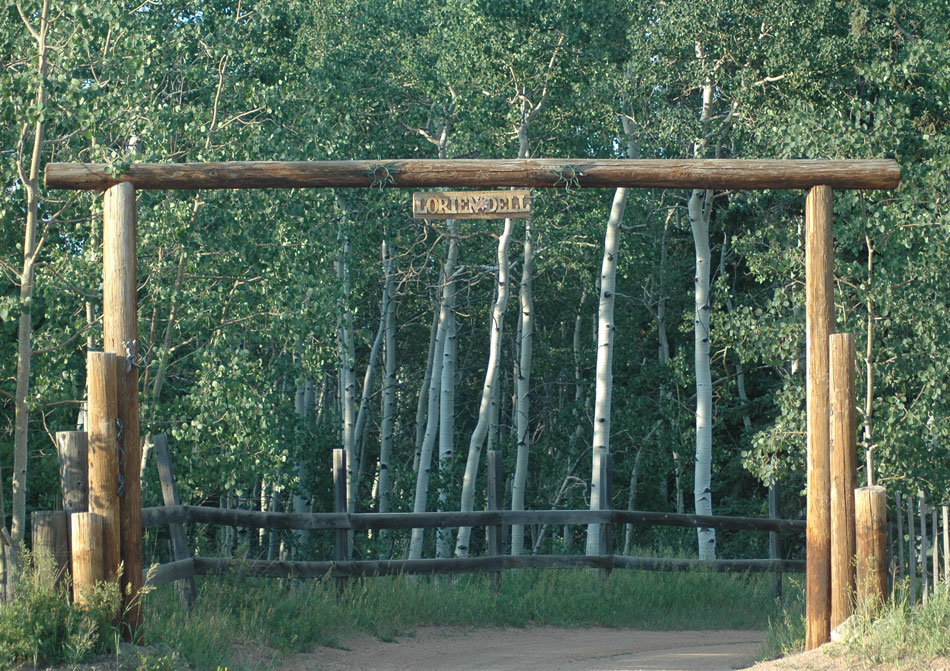
Yes - we know we're cheesy romantics, but we have another side that balances this -- a side that keeps us both sane. Lynn soon realized that, if she were to devote so much of herself to training, showing, breeding and raising the best breed of dog on earth (and George to devote himself to supporting them!), we must do it together, with as much openness as possible.
We also realize that, for our breeding program to succeed, we need on-going help from the owners of Lorien Dell puppies.
Whether you are thinking about adding a Lorien Dell Berner to your life or are just '"window" shopping,' we've included this portion of our website to help you understand "where we come from" as breeders. The world of dog breeding is an increasingly complex and interesting one, and so the following information may answer some of the typical questions you might have, both about us and the concerns of dog breeding in general:
- What are your standards for breeding puppies?
- The Importance of a Pedigree and the Value of Tracing Lineage
- Sample Pedigree
- Health Screening of Sire and Dam
- Hip and elbow dysplasias
- Progressive retinal atrophy (PRA)
- Hip and elbow dysplasias
- The Importance of a Pedigree and the Value of Tracing Lineage
- Why do you require health screenings for the puppies you place?
- Evaluating Temperament of a Prospective Parent
- How do you choose prospective sires?
- Why do you require Obedience Training for your puppies?
- Why do you emphasize AKC Championship and Merit Titles?
- Obedience Titles
- Working Titles
- Conformation Titles
- Versatility Awards
- Obedience Titles
- Companion or Potential Show Quality - What's the difference?
- Why do you require your registered names to be in accordance with a "litter theme?"
- How do you raise your puppies?
- How do you match your puppies with their families?
- Why do you require completing such an extensive Questionnaire?
~~~~~~~~~~~~~~~~~~~~~~~~~~~~~~~~~~~~~~~~~~~~~~~~~~~~~~~~~~~~~~~~~~~~~~~~~~~~~~~~~~~~~~~~~~~~
What are your standards for breeding puppies?
To begin, we chose a line of strong German dogs from which to develop our own line. These dogs possess intelligence, loyalty, soundness, excellent movement, wonderful personalities and a somewhat rugged look that reminds us of the working farm dogs we saw in Europe. While there cannot be any guarantee that an animal will never have health problems, we sincerely hope that by breeding only sound dogs with stable temperaments, we may make a positive contribution to the future of our breed, maintaining its strengths and, as much as possible, reducing the risk of suffering and shortened life spans from genetically transmitted conditions. This means we must have the strength and determination to make hard decisions regarding our breeding stock. We have therefore drawn lines in the genetic sand regarding the health issues we all know and loath: We say "no compromise" on genetically-traceable health issues and emphatically say "yes" to sturdy hips, knees, shoulders and elbows and clear, healthy eyes! These and happy tails come from strapping good Berners. There is no other way.
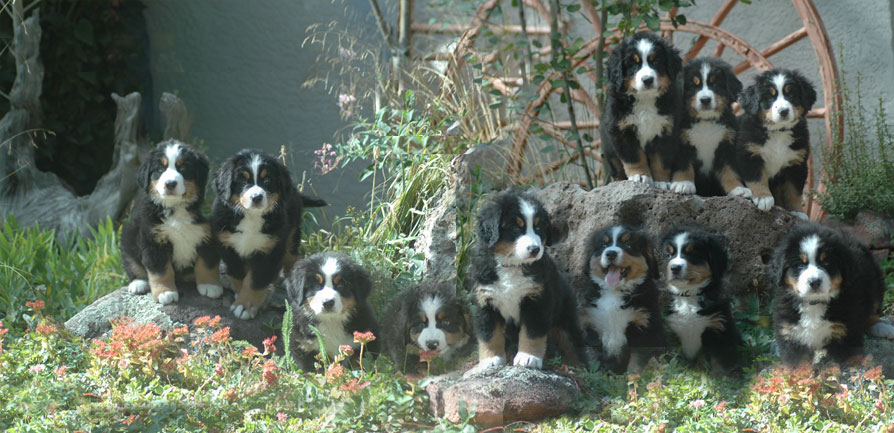
Therefore, following are some of the things we consider in the process of bringing puppies into our families:
The Importance of a Pedigree and the Value of Tracing Lineage
![]() Traits will not disappear by themselves. Nature will not save us because natural selection has nothing to do with dog breeding. Dog breeders in general need to face genetic defects as a realistic part of the problems encountered in the process of producing good sound animals.
Traits will not disappear by themselves. Nature will not save us because natural selection has nothing to do with dog breeding. Dog breeders in general need to face genetic defects as a realistic part of the problems encountered in the process of producing good sound animals.
--Dr. George A. Padgett, DVM (A Founder of Genetic Disease Control (GDC)
The bottom line to all of this is that you need a way to tell if your dog's breed lines are carrying potentially harmful hereditary defects and, in as much as possible, mitigate the risk of transmitting hereditary defects. The only way to approach this is to have a good understanding of your dog's ancestral make-up. This is why it is so important to have a dog registered with the AKC: Having a comprehensive knowledge of your dog's lineage enables you to make enquiries into its background, thus accessing family health information and allowing you a choice to decide what type of dog is more likely to suit the discipline or life-style you would ask of it.
With Bernese, certain lines have been bred for their working instincts, while other are appreciated for their cheerful, well-balanced approach to life. Some are quiet-natured, preferring to stay at home on the couch, while others stand out for their substance, head-shape, coat, movement or "drafty" type.
A good pedigree - once understood - can tell all these things and more about a particular dog; an unregistered dog can tell you nothing other than what you see before you.
Most Berners taken in by rescue organizations are from unknown ancestry. Many started their lives by being advertised as 'Berner Puppies for Sale' in a local newspaper, but in reality, this is the nearest that they will get to being Berner in type.
Many others come from "puppy mills," businesses run with little thought given to responsible breeding methods. When you buy a puppy from an unknown background, you run a higher risk of ending up with a dog with an unstable nature or other hereditary faults that won't manifest until the dog is mature. This is why most rescue groups insist that re-homed dogs be neutered or spayed.
The pedigree of a registered dog, on the other hand, can provide a mine of information. Not only does that pedigree give you the names of the dogs within it, but it can also show important health information and merit titles (which demonstrate both the abilities of the dog as well as the commitment of its breeder to the care and development of their own dogs).
Sample Pedigree

See http://www.dogstuff.info/importance_of_complete_pedigrees_kral.html for a good summary of the importance of pedigrees and http://www.bordercollierescue.org/breed_advice/Guests/breeding.html for a description of various types of breeding programs.
See http://pbskids.org/dragonflytv/games/game_dogbreeding.html for a fun internet game to help understand breeding techniques.
Health Screening of Sire and Dam
Although screening for hereditary diseases doesn't guarantee perfect health for the next generation, it does improve the odds.
We need to quit whispering about defects, and gossiping about defects, and instead set up a sound program that allows the standard selection procedures to go on so that we breed good dogs and avoid major defects. -- Dr. George A. Padgett, DVM
- In the past, the Institute for Genetic Disease Control in Animals (GDC) evaluated dogs at one year of age by X-ray.
- OFA evaluated dogs at two years of age by X-ray. Dogs found to be free of dysplasia are issued a certificate and a registration number.
- OFA and GDC have combined their databases and now evaluate and issue registration numbers under OFA auspices (http://www.offa.org/ofagdc.html). With the closing of GDC, the OFA has agreed to archive and make available GDC test results for historical purposes. These results can be found on the OFA website alongside traditional OFA results. To help avoid confusion, all GDC numbers on the OFA site are preceded by the letters "GDC". They are also maintained in a separate database tables.
Progressive Retinal Atrophy (PRA) is a hereditary eye disease that causes blindness. The following facts are known:
- There are early and late onset forms of the disease with symptoms being detected from a few months old to five years of age.
- Blindness can occur any time after one year old.
- Annual Canine Eye Registry Foundation (CERF) eye examinations can detect symptoms of the disease and lead to a definitive diagnosis. Dogs that pass this exam may be registered with either CERF or the GDC but the exam must be repeated yearly.
As costly and heartbreaking as it can be (and has been), we will not compromise by breeding our dogs if a health screening reveals a genetically transmitable condition that causes pain or dysfunction.
Why do you require health screenings for the puppies you place? (even companion dogs, since these will be spayed or neutered anyway?)
We require health screenings for two primary reasons:
(1) For the Puppy and its New Family: If your dog tests marginally in a health area, you become alerted to a condition which may affect your dog and your family much less drastically if you are aware of it before it becomes a serious problem. Unfortunately, as sensitive as your Berner will be to you, they are not the greatest communicators of their own pain precursors. Unnecessary suffering often occurs because we don't recognize early signs of trauma or conditions that can lead to permanent injury. With awareness of a condition, you can exercise preventative measures proactively. For example, if testing finds that your dog has marginal elbows or loose joints, you will be all the more careful to limit his jumping from heights (e.g., from the car or from off the porch). The hope (and expectation) is, since you were a bit more protective of him, he (and you) may never experience the pain and suffering that dysplasia or arthritis brings.
(2) For the BMD Community: We are part of a community that deeply cares about the future of our breed. Good lines are established and maintained by good breeding practices. Statistics become more meaningful when they encompass all available data -- including that of companion siblings. We have an obligation not only to our kennel name but also to the future of the BMD breed to contribute as much information as we can into the national data bases. If, for example, we place three potential show puppies in a litter of nine and do not request health tests on all the litter, we lose 67% of the data that tells us whether this breeding decision was a wise one.
If you ignore the risk and reality of the problems, you and your dogs will suffer. Evaluate your dogs, publish the results, and breed only the best. ---- Fred Lanting, author of "Canine Hip Dysplasia"
Evaluating Temperament of a Prospective Parent
Temperament is a combination of heredity and environment, including early puppy teaching by the dam, so it is important to know the temperaments of the parents of your puppy. Is the dam a confident dog, capable of excelling in a show situation both physically and mentally? Is she a good mother, instinctively caring for her pups? How is she with visitors to her pups? Is she adaptable and a pleasure to live with in any setting?
It is also important to be aware of how the sire or dam deals with new situations: We make it a priority to put our prospective parents into all kinds of environments, including road trips and motel stays, with early social contact with many people and dogs, and we ask the same questions for a prospective mate.
~~~~~~~~~~~~~~~~~~~~~~~~~~~~~~~~~~~~~~~~~~~~~~~~~~~~~~~~~
How do you choose prospective sires?
Before choosing a sire for our pups, we evaluate his genotype in detail. This involves
 - Researching the dogs in his pedigree back at least 4 generations for health screening data, age and cause of death.
- Researching the dogs in his pedigree back at least 4 generations for health screening data, age and cause of death.
- Reviewing BernerGarde records for familial information and learning as much as possible about dogs of similar ancestry.
- Speaking to his owner and other breeders who've used him or have expressed interest in him to learn what he's produced in terms of soundness, health, and temperament. This will include a full complement of health screening on the dog, a thorough discussion of the dog's strengths and weaknesses (both phenotypic and genotypic) and information on the health screening (hips, elbows & eyes) of all their puppies.
- Asking questions...and more questions...
Putting all of this together, we formulate an idea of what positives and negatives he's more and less likely to produce and how that fits with our breeding program.
Why do you require Obedience Training for your puppies?
Berners are working dogs, although you might not think so as you sprawl on the couch with one. Because its correct temperament is that of a true working dog, the Bernese should be assertive in some situations and aggressive if necessary. "Necessary" to a dog may be simply taking charge when no one else seems to be in charge. BMDs therefore need strong leadership in their humans. This concept should be well understood before taking on a puppy. Puppies need formal obedience training during their first year. In their routine at home, puppies, like human toddlers, must have consistency in the guidelines you and your family, (especially your children), offer them.
Puppies typically experience a surge in their will to be "in charge" at 4-6 months of age and then again at around nine months.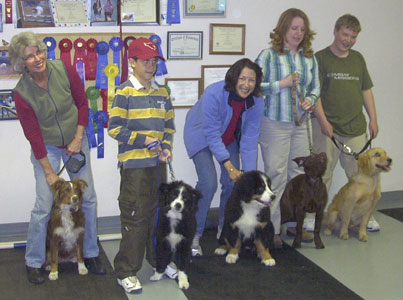 Formal obedience training, using positive reinforcement, builds the dog's will to serve his master and usually smooths out these critical developmental periods. Once he has adapted to the Obedience Training routine, most young Berners respond with joy and excitement. Formal training should continue at least through the dog's first year.
Formal obedience training, using positive reinforcement, builds the dog's will to serve his master and usually smooths out these critical developmental periods. Once he has adapted to the Obedience Training routine, most young Berners respond with joy and excitement. Formal training should continue at least through the dog's first year.
As a prospective BMD owner, you need to anticipate the day when your Bernese may challenge you with growling or even snapping if you haven't developed self discipline in him as a youngster. Though the Bernese is not typically thought of as a tough dog, some are. To do the work he did in his native Switzerland, the Bernese had to be protective. Because of that inherited tradition of loyalty to hearth and family, a Berner needs a job. An idle Berner may be rude and mischievous. Our sad experience with families who have neglected to train their puppy, allowed their puppy to dominate them or their children and subsequently found their households in chaos, has caused us to require Obedience Training in our contract and provide a rebate to the owners when they complete the training.
Why do you emphasize AKC Championship and Merit Titles?
As a matter of practice, we desire that both dam and sire have proven themselves by attaining AKC championship and merit titles. To us, this isn't just a matter of bragging rights for ribbons on a wall - these acheivements are some of the primary indicators of the attributes and qualities we want to promote in Lorien Dell Berners.
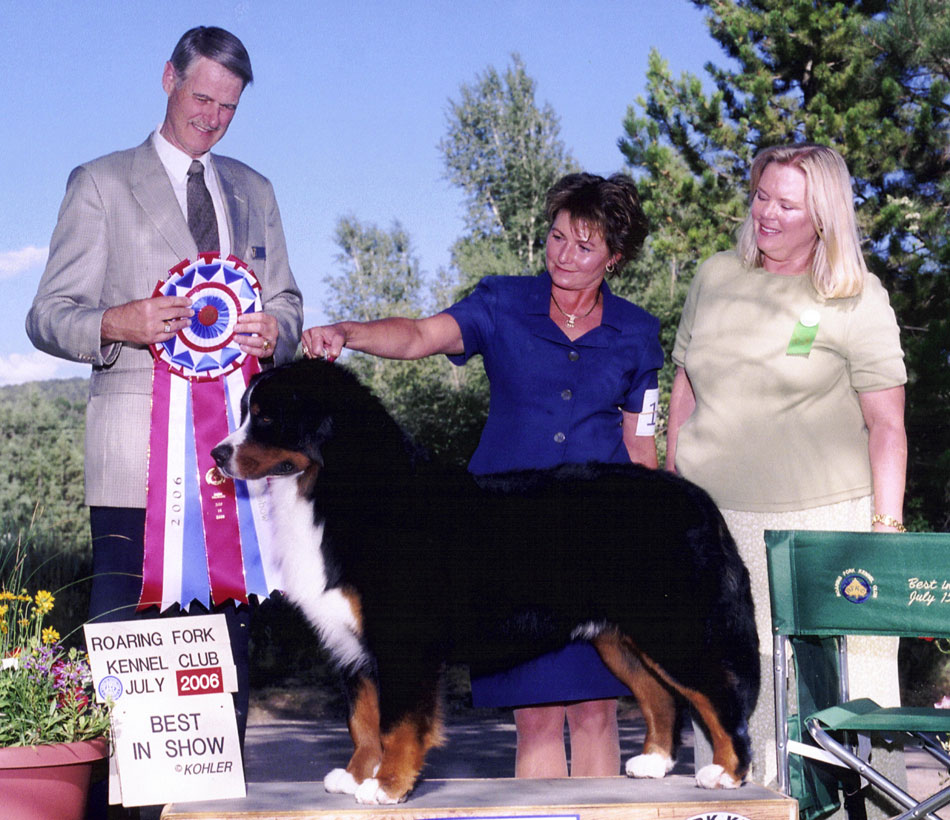


Merit Titles: Merit titles and awards demonstrate both the abilities of the dog as well as the commitment of the breeder to the care and development of their dogs. Whether you enjoy your Berner as a family companion, a show dog, or an obedience partner, the structure and temperament you cherish today has its roots in the working farmhand role played by its ancestors. The pictures of Berners hooked to a cart, pulling milk cans and kids through a European village tell us much about the Bernese.



They tell us that the BMD must be physically strong and sound, well trained, adaptable, and of good disposition. They must work well with their handler in a variety of situations on the farm or on their way into town. The many titles available to working dogs provide a means to evaluate and measure how a dog a dog is maintaining his heritage characteristics and capabilities. Obedience trials, Canine Good Citizen tests, Therapy Dog International tests, Agility Trials, Conformation Shows, Herding instinct tests and Drafting are all ways to involve ourselves in the heritage of the breed and gain a fuller understanding of our dogs, not to mention that for most Berners, they are jobs they love to do! (Click here to see this video of Norwegian sled Berners)
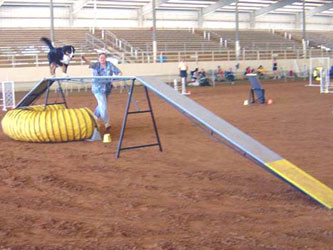

Click here to see Margaret and LorienDell's Bernhilde (Delta) on their way to a MACH title (Master Agility Champion).
Bernese with suitable temperaments enjoy working as therapy dogs by visiting hospitals, nursing homes and rehabilitation facilities. Most Berners like humans, love being petted, will sit your feet and are soft and furry. What more could anyone ask from a therapy dog? (see Cindy's CNN story)


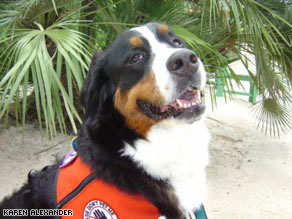
The Bernese Mountain Dog Club of America (BMDCA) honors many conformation, obedience, and working titles. Some titles and awards you may see on pedigrees are:
Obedience Titles: To earn an obedience title, the dog must have a passing score of 50% of possible points or better, and an overall passing score at three different obedience trial competitions under three different judges.
CD - Companion Dog (First Level Obedience Competition, basic obedience exercises)
CDX - Companion Dog Excellent (Intermediate Level Obedience Competition, more advanced obedience work)

Team Obedience at the BMDCA National Specialty
Working Titles: There are many AKC titles Some popular working titles are:
CGC - Canine Good Citizen (see http://www.doggroups.com/dog-training/item/7 )
TDI - Therapy Dog International tested (see http://www.tdi-dog.org/aboutus.html)
NDD - Novice Draft Dog (see http://www.gsmdca.org/draftarticle.htm )
HIC - Herd Instinct Certified (see http://www.softcom.net/users/aprilr/herding_and_the_bernese_mountain.htm)

.jpg)
![]() Rufio the Herder
Rufio the Herder ![]() Agile Delta (Top 5 AKC BMD Agility 2010)
Agile Delta (Top 5 AKC BMD Agility 2010)
Ch - Champion of Record - earned by gaining 15 points in conformation wins. Points awarded is determined by the number of other entries the winning dog defeats. A dog must win at least two majors (by winning at two different shows under two different judges where there are enough entries defeated to equal 3-5 points by the AKC point system.)
 BOB - Best of Breed in All-Breed Show in conformation
BOB - Best of Breed in All-Breed Show in conformation
BIS - Best in Show at an All-Breed Show in conformation
BISS - Best in Show Specialty (where only dogs of the same breed are competing
in conformation)
TP - Top Producer of Champions. The BMDCA honors those dogs, owned by members, who have produced Champions and Working Title Holders. To be a
BMDCA Top Producer a dog must have sired at least six champions or working
titled dogs; a bitch must have produced at least four.
1) must be an AKC Champion.
2) must have earned a BMDCA Novice Draft Dog title.
3) must have earned one of the following other AKC titles: (a) Companion Dog, (b) Tracking Dog, (c) Novice Agility Dog, (d) Novice Agility Jumper, (e) Novice Agility Preferred, (f) Novice Jumper Preferred, or (g) American Herding Breed Association Junior Herding Dog.
Companion or Potential Show Quality - What's the difference?
 Breeders classify their dogs in two categories: companion and potential show. People sometimes fear that when they ask for "just a pet" they will be getting an inferior dog. It's important to know that all LorienDell Bernese are always companions first, and potential show dogs second. A "potential show" puppy is a puppy that has been determined to have a good chance of exceeding in the conformation show ring and potentially qualifying to become breeding stock. (Not all potential show pups become showdogs, not all showdogs become champions and not all champions become puppy parents). Although many pups from a litter may be of show quality, most will become companions only.
Breeders classify their dogs in two categories: companion and potential show. People sometimes fear that when they ask for "just a pet" they will be getting an inferior dog. It's important to know that all LorienDell Bernese are always companions first, and potential show dogs second. A "potential show" puppy is a puppy that has been determined to have a good chance of exceeding in the conformation show ring and potentially qualifying to become breeding stock. (Not all potential show pups become showdogs, not all showdogs become champions and not all champions become puppy parents). Although many pups from a litter may be of show quality, most will become companions only.
Why do you require your registered names to be in accordance with a "litter theme?"

First, understand that the puppy's "call name" may or may not have anything to do with the "registered" name. That's entirely up to the puppy's new family.
Using "Litter Theme" names is one of several ways we use to track our dogs from generation to generation. All of our puppies' registered names are in the format, "Lorien Dell's" <ThemeName>. We chose this convention because it seemed creative and fun, and we all have a good time coming up with theme names for the pups.
(See examples in the Katja, Lu and Puffin litter web-pages).
How do you raise your puppies?

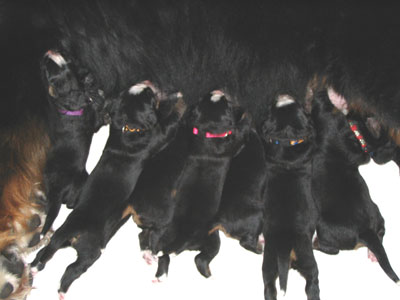

Lynn spends the next 8 weeks doting over babies and mom, watching, weighing, handling, cleaning up and supplementing them, even sleeping on the couch for their first two-three weeks.
During the whelping box time, we often relax on the couch or in the box watching TV while snuggling a pup.



We begin handling and socializing them as soon as possible. All through their puppyhood, Berner lovers from our neighborhood and church cycle through Lorien Dell for "puppy fixes." We also invite local Potential Puppy Owners to make regular visits as the pups develop. Besides the joy of sharing these little wonders, we think a lot of human interaction helps the pups bond to their humans.




By this time mom is leaving them alone more and more; they feel and act like they want more freedom (see "jailbirds" below) and they're learning to tussle with each other and play with toys.


As soon as weather permits, we lead a daily stampede through the living room to the deck, calling, "puppy, puppy, puppy!" as they happily follow us. There they have even more room and may access the backyard. From about 5 weeks, weather permitting, they can play on the lawn, but under a canopy with supervision (danger from hawks). The stampede reverses in the evening, or sooner if it's cold. (see this video of Berner pups in Spain)


Puppies under Backyard Canopy
We want to do all we can to ensure that our Bernese Mountain Pups grow into affectionate, fearless, inquisitive Bernese Mountain Dogs.
Since we live in a quiet woods, we purposely try to expose the puppies to a variety of sounds: besides the "riot" barking of the adult dogs whenever someone says, "walk", "squirrel" or the doorbell rings, the puppies hear music, hear (and see) TV (lots of Animal Planet (!)), hear and see the vacuum cleaner, and the crash and banging of dog dishes as Katja deliberately drops hers on the tile floor (every feeding).


Lynn also conditions them to rattling paper and they have joined our home cell meeting instrumentals and singing with earnest puppy howls. By the time they are ready for their new homes, they have run and played on tile, dirt, grass, crushed granite, concrete and maybe even burrowed in snow.
During their first weeks of development, we monitor the physical and social progress of each puppy. Between 7- 8 weeks old the litter is microchipped. At 6 weeks old, all the dogs and puppies are wormed; then at 8 weeks old, they are all wormed again and they get their first Vanguard 5 shot.
How do you match your puppies with their families?
We consider the process of placing a puppy in a new family to be a serious responsibility, one not that much different from placing a human baby in an adoptive family (having experienced that process with our own son). From the day of birth, we note such characteristics as sociability, dominance, levels of activity, eating habits and weight gain. Then, between 7 to 8 weeks old, we formally administer the Volhard Temperament Test to guide our own temperament observations. We also use the Pat Hastings' Puppy Puzzle for structure, movement and breed type to help us determine the success of each breeding. This lengthly evaluation provides guidance for us on the pluses and minuses of a particular breeding and how it fits with our breeding goals. It also gives us a final perspective on each puppies' structure for show and breeding potential.
We also consider what people might want to do with the progeny ...Not every puppy is suitable for every lifestyle. Could they do therapy work? Drafting? Tracking? Herding? Agility? Does the puppy have a strong desire to please or is he more independent? Where does he fit in the puppy pack? Is he a leader or a follower? How will he behave off leash in the woods? Is he outgoing or quiet? Will the puppy play cheerfully with the kids - how about their other dog(s)?
Why do you require completing such an extensive Questionnaire?
A mis-homed Berner is a very sad and distressing circumstance for both puppy and humans. We take the responsibility of placing our puppies in their new homes very seriously. We start the adoptive process by requesting completion of a comprehensive questionnaire. Honestly and candidly completing the questionnaire not only helps us better match you to a puppy; hopefully, it helps you better consider the profound effect a BMD will have on your family and further stimulate your thought processes about responsible dog ownership. Some of the questions may cause you to reconsider the impact of the responsibility and consequences of taking on a Bernese -- better NOW than three months after you've taken a puppy home. Altogether, the information helps us both determine if a Lorien Dell puppy will fit into your family and lifestyle.
Review of our puppy contract will help you understand the terms we expect as breeders and also clearly defines what you can expect from us. You may have questions for us at this point as well. Then, assuming we are mutually satisfied, we invite you to visit us and interact with the puppies at our home. If you live too far away to visit, we do the best we can with phone calls, pictures and emails. Those interactions combined with your criteria and our ongoing evaluations and observations, help us to recommend a puppy. Our goal is always to best match the puppy's temperament, disposition, personality and even size to their new family's desires. We work to make a match for a lifetime.



To prepare for final placement, we'll microchip, vaccinate, register and load you with as much information on nutrition, exercise, supplements and grooming as you can take! (see our Puppy Operating Instructions).
All this accomplished, your puppy can go home as early as eight weeks old.
Although we don't aspire to be "big" breeders, we will always endeavor to be responsible ones. We want to place our Berner "children" in homes where together they may realize their full potential: the humans "enobling" their Berner with sacrificial love and care and the Berner expanding the hearts of their humans as only a Berner can do. We believe we've succeeded -- most of our "puppy people" have been responsive to our goals and have honored the terms of our contracts. We commit to do the same in return: a Lorien Dell Berner comes with a lifetime of support from us, as well as from the wonderful people of the Bernese Mountain Dog Community.












